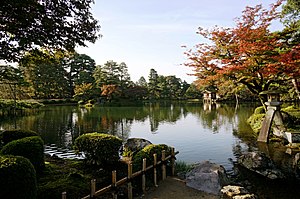Kenroku-en
The Kenroku-en ( Japanese 兼 六 園 , dt. Garden of the simultaneous 6 [attributes] ) in Kanazawa is with the Kairaku-en and the Kōraku-en one of the three famous gardens of Japan ( 日本 三名 園 , Nihon san meien ).
Historical background
The Kenroku-en was the gardens of the Maeda family, the rulers of the former province of Kaga as changing garden created. They used the ridge between the Asanogawa and Saigawa rivers, which leads to the castle, but which is separated from the garden by a deep cut. Due to its altitude, the Kenroku-en offers a good view of the wide landscape, such as the Hakusan Mountains in the southwest.
The "Tatsumi-yōsui" water channel, which was laid out in 1632 as a fire protection measure for the castle, was used to supply the garden with water. For this purpose, water was branched off from Saigawa 20 km northeast of the castle and led over the ridge using the natural slope to the castle or the garden in front of it, a third of which was underground.
After a few smaller forerunners, construction of today's garden began in 1676 under the 5th boss of the house, Maeda Tsunanori, who also entertained his guests there. The garden was generally called "Renchitei" (lotus pond garden), when it was built it was called "Hasu-ike no ue oroji", for example "Free field above the lotus pond". In 1759 part of the garden was lost due to a major fire, from 1774 the 11th boss of the house, Maeda Harunaga, gradually rebuilt it. At the request of the 12th chief, Maeda Narinaga, Matsudaira Sadanobu , Prince of Shirakawa-han , suggested the current name "Kenroku-en" for the garden. The 13th boss, Maeda Nariyasu, enlarged the Kasumi-ga-ike, planted handsome trees, and had the "Tatsumi goten" (today "Seisonkaku") built in 1863.
In 1874 the Kanroku-en was made fully accessible to the public. In 1922 the garden was named "meishō", then in 1985 as "tokubetsu meishō".
The "Six Principles" to which Matsudaira Sadanobu refers when he was named are laid down in an old Chinese garden book. According to this, an outstanding landscape garden has the following six qualities:
- Vastness ( 宏大 kōdai ) and seclusion ( 幽邃 yūsui ),
- Craftsmanship ( 人力jinryoku ) and traditional ( 蒼古 sōko ),
- running water ( 水泉 suisen ) and wide view ( 眺望 chōbō ).
The garden in detail
- From the old gate to the garden opposite the castle, the renchimon (lotus pond gate), only the steps remain.
- The Hisago pond takes its name from its shape, that of a bottle gourd. The construction of the garden began from this side, which is close to the castle.
- The "Green Waterfall" (midori taki) is 6.6 m high and 1.6 m wide, unusually large for a Japanese garden. It was created in 1774.
- The "Pumpkin Tea House" (Yūgao-tei) next to it was also built in 1774.
- The fountain was constructed around 1860 based on a western model, making it the oldest in Japan. He gets his water from the higher lying pond "Kasumi-ga-ike".
- There are 18 stone lanterns scattered around the garden, the most famous being the "Kotoji lantern". With its striking two-leggedness, it became the symbol of the garden. Kotoji is actually the name for the two-legged bridge, as it is used for each individual string of the koto .
- The "Hazy Pond" (Kasumi-ga-ike) is the largest of the four ponds in the garden and occupies its center. It has an area of 5826 m², the island in it has the shape of a turtle.
- The "bridge of the flying wild geese" (karigane-bashi) consists of eleven stones, laid in a wedge shape, to cross the water.
- The "Wendelstiege Mountain" (Sasaeyama) takes its name from the spiral-shaped path to the top, where there is a rain cover in the form of a solid umbrella.
- The Karasaki pine comes from Karasaki on Lake Biwa. There is a sprawling pine tree on the bank and is one of the eight views of Lake Biwa .
- Yukitsuri for protecting trees in winter can be found in many gardens. But they are particularly important here because of the snowy winters on the Lake Japan side. From November 1st the ropes will be pulled up.
Outside the part of the garden that requires entry fees are:
- the Seisonkaku villa , which the 13th Prince Maeda had built for his mother in 1863. Today the building is open to the public and is used as a museum.
- In the "holy spring" (Kinjo reitaku) gold is said to have been found in ancient times.
- A former samurai house was moved to this site in 1922.
The garden is open all year round and is known for its beauty in all seasons. On certain occasions, the garden is also opened with lighting at night. There is a fee to enter.
Yūgao tea house
Characteristics
- Sponsor: Ishikawa Prefecture
- Opening: 1874
- Area: 100,740.92 m²
- Tree population: 5000 trees and 3500 bushes, classified into 147 species
- Another 3200 plants on walls and fences
- Facilities: teahouses, including the large "Shigure-tei", reconstructed in 2000
Remarks
- ↑ Tatsumi ( 辰 巳 ・ 巽 ) is the name for southeast.
literature
Kenroku-en folders.
Web links
- Official website (Japanese, English)
Coordinates: 36 ° 33 '42.69 " N , 136 ° 39' 45.07" O






